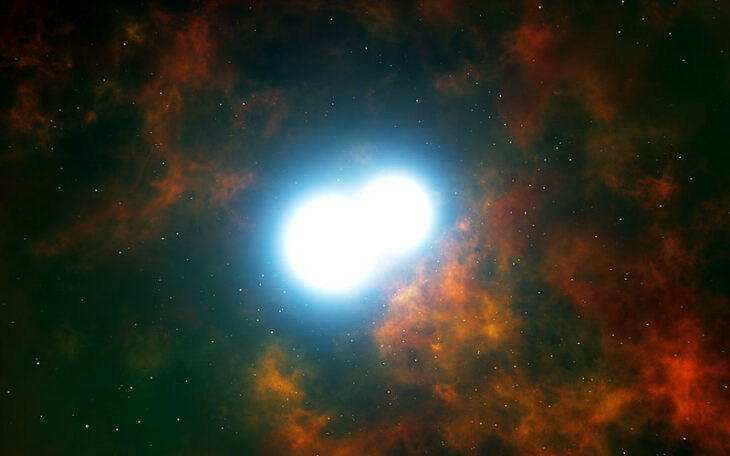Marvel movie and comic book fans may be familiar with the story of Thor’s hammer, Mjolnir, which was forged with metal from the heart of a dying star. While no one will be granted the powers of the god of thunder anytime soon, some of the heavy metals around us may have come from stars already dead.
Like living things, stars have life cycles. When a star is around 10 times the mass of the Sun or smaller, the last stage in its life cycle is a white dwarf. During this stage, the stars are compacted into the same volume as the Earth and as hot as 100,000 Kelvin, which is about 100,000°C or 180,000°F. They no longer smash elements together in their core to produce energy through nuclear fusion, like other stars do. Instead, they’re held up against gravity by quantum mechanical weirdness while they slowly radiate their heat away. These properties are why scientists sometimes refer to white dwarfs as dead stars.
But if the circumstances are right, a white dwarf can get one last burst of energy. White dwarfs have an upper size limit of 1.4 times the mass of the Sun. If a star is pushed over that limit, by having surrounding gas and dust fall onto it or by colliding with another white dwarf, gravity overtakes its support structure. This creates a rapid compression that causes a sudden chain reaction of nuclear fusion ending in an explosion called a Type Ia supernova. Researchers estimate that one of these explosions happens in the Milky Way Galaxy every 100 to 700 years.
A team of astrophysicists wanted to study this scenario and a rarer, alternate one. If the star is rotating while it receives more material, it could collapse directly into an even denser neutron star and fling off excess matter without exploding. The team simulated the aftermath of 6 different scenarios where a white dwarf collapsed after exceeding its size threshold, a period known as postbounce. In these scenarios, they varied the white dwarfs’ speed, width, temperature, and how much they exceeded their size threshold.
Then they plugged initial conditions like the masses of the white dwarfs, if and how fast they spun, their radii, and temperature, into a program called ALCAR. ALCAR simulates fluid physics and the behavior of tiny, energy-carrying particles called neutrinos in 2 dimensions. It’s taxing for computers to perform these calculations, so astrophysicists typically only simulate postbounce for fractions of a second. However, this team performed a longer-term simulation of 4.5 to 7 seconds to better understand how the layers ejected from white dwarfs would behave.
Their simulated white dwarfs collapsed quickly, ranging from as slow as 0.8 seconds to as fast as 0.04 seconds. After that, the scenarios diverged, with their non-rotating white dwarfs exploding into a supernova and their rotating white dwarfs forming neutron stars at their centers. In the latter case, the rest of the matter in the star was packed so densely that neutrinos collided with it, heating it and pushing it away from the star.
Next, the team focused on the ejected material. The amount of material ejected by the collapsing stars ranged from 0.005 times the mass of the Sun, or about 1,700 Earths’ worth, to 0.05 times the mass of the Sun, or about 17,000 Earths’ worth. And it could assemble elements as heavy as nickel.
The researchers concluded that the outer layers of collapsing white dwarfs, which get thrown off during these events, could change rapidly. They found that the ejected material was proton-rich and formed lighter elements early on, but was later neutron-rich and formed heavier elements.
The team recommended that future researchers make more refined, 3-dimensional models of white dwarfs before they collapse. They suggested astrophysicists could use these models to estimate what percentage of elements in the solar system might have come from collapsing white dwarfs.


